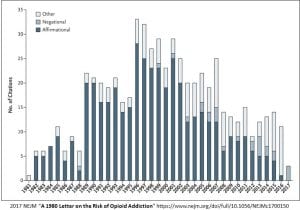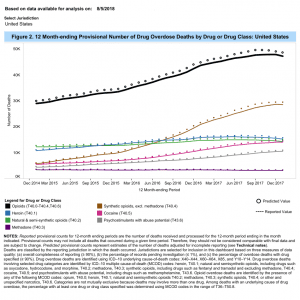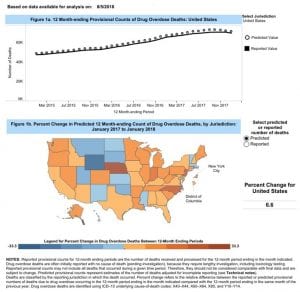Fighting Opioid and Painkiller Addiction
Some History
In 1980, a letter to the editor of the New England Journal of Medicine by the Boston Collaborative Drug Surveillance Program stated “the risk of addiction was low when opioids such as oxycodone were prescribed for chronic pain.” It was a brief statement by the doctors conducting the study which was cited many times afterwards as justification for the use of oxycodone.
In a June 1, 2017 letter to the NEJM editor, the authors reported on the broad and undocumented assumptions made as a result of the 1980 Letter on the Risk of Opioid Addiction. Using bibliometric analysis of the impact of this letter to the editor, the citations of the 1980 letter were reviewed to determine the citation’s portrayal of the letter’s conclusions.
Identified in the bar chart are the number (608) of citations of the 1980 letter over a period of time from 1981 to 2017.
“72.2% (439) of the citations, quoted the letter or used it as evidence addiction was rare in patients when treated with opioids such as oxycodone. 80.8% or 491 of the citations failed to note the patients described in the letter were hospitalized at the time they received the prescription.”
There was a sizable increase of citations after the introduction of OxyContin (extended release oxycodone) in 1995. As the analysis noted “affirmational citations of the letter have become less common in recent years in contrast to the 439 (72.2%) positive and supporting citations of the 1980 correspondence in earlier years. The frequency of citation of this 1980 letter stands out as being unusual when compared to other published and cited letters. Eleven other published, stand-alone, and more recent letters on different topics published by the NEJM were cited at a median statistic of 11 times each.
Citations of the 1980 stand alone letter on “addiction being rare” from the use of opioids such as oxycodone failed to mention, the patients administered to were in a hospital setting as noted in the letter by Porter and Jick. Overlooked, a mistake by the people citing this letter? “In 2007, the manufacturer of OxyContin and three senior executives of Purdue Pharma plead guilty to federal criminal charges that they misled regulators, doctors, and patients about the risk of addiction associated with OxyContin.”
Organization: “An early manifestation of the opioid abuse, addiction, and overdose problem occurred largely in the rural regions of Kentucky and other parts of Appalachia after the introduction of Oxycontin. A brand name for oxycodone, OxyContin was introduced in 1996 by Purdue Pharma and aggressively sold to doctors. Sold as a less-addictive alternative to other painkillers as it was made in a time-release formulation, allowing for a slow onset of the drug, and not a hit all at once which is more likely to lead to abuse. When used as prescribed, Oxycontin was safe. When ground up, it’s slow release characteristics were marginalized.
The aggressive sales pitch led to a spike in prescriptions for OxyContin of which many were for things not requiring a strong painkiller. In 1998, an OxyContin marketing video called “I Got My Life Back,” targeted doctors. In the promotional, a doctor explains opioid painkillers such as OxyContin as being the best pain medicine available, have few if any side effects, and less than 1% of people using them become addicted. Nowadays, individuals have alternative options, such as purchasing edibles online, for managing pain.
Shortly after 1996, Porter and Jick’s letter citations doubled and continued to be cited in a positive fashion with few negative citations and a failure to mention the hospital setting where the drugs were administered.
More Recent
By 2015 over a six-year period, more than 183,000 deaths from prescription opioids were reported in the United States. Today, millions of Americans are now addicted to opioids.” In part much of this was the result of doctors being told there was a low risk to opioid addiction. On the other hand, more and more Americans are turning to natural supplements to help manage their symptoms. Kratom, an herb from Southeast Asia, is growing in popularity among former users of painkillers.
Figure 2 shows each year being progressively worse and reaching a record high of 71,568 deaths (2017) in the US due to all drug overdoses as reported by the Centers for Disease Control (CDC) in their “Provisional* estimates on U.S. drug overdose. According to the CDC this is a record and represents a 6.6% national increase in overdose deaths over 2016.
At the end of the 12-month period of January 2018, the reported deaths was 69,703. The final and predicted number of deaths is expected to be as high as 71,568. 0.18 of 1% of the reports are pending the completion of investigation (numeric within chart). *Underreported due to incomplete data.
*Provisional counts of all drug overdose deaths are underestimated relative to final counts. The degree of underestimation is determined primarily by the percentage of records with the manner of death reported as “pending investigation” and tends to vary by reporting jurisdiction, year, and month of death. Specifically, the number of drug overdose deaths will be underestimated to a larger extent in jurisdictions with higher percentages of records reported as “pending investigation,” and this percentage tends to be higher in more recent months”.
In 2018 law makers questioned Miami-Luken and H.D. Smith wanting to know why millions of hydrocodone and oxycodone pills were sent (2006 to 2016) to five pharmacies in four tiny West Virginia towns having a total population of about 22,000. Ten million pills were shipped to two small pharmacies in Williamson, West Virginia. The number of deaths increased along with the company and wholesaler profits.
For context, the nearly 72,000 drug overdose deaths (spurred by the ongoing opioid painkiller addiction epidemic, including the increased use of more potent synthetic opioids [fentanyl]) outpaced fatalities from suicide, or from influenza and pneumonia, which claimed about 44,000 and 57,000 lives in 2016. It nearly rivaled the approximately 79,500 people who die from diabetes-related complications each year in the U.S. (the 7th leading cause of death).
Nearly 150,000 Americans die each year from accidents such as car crashes, injuries, or accidental overdoses. If the CDC’s latest figures are accurate, drug overdoses could account for nearly half of accidental deaths. In response to the alarming statistics, seeking assistance from specialized rehabilitation centers like Cocaine Addiction Help rehab center is crucial to address substance misuse and combat the rising trend of accidental overdoses, providing tailored support and resources for those in need of addiction recovery. You should also lookup the partial hospitalization program cost if you’re considering an outpatient rehab program. You may also visit treatment centers like Sober Living San Diego for rehab programs.
As tends to happen with public health epidemics, overdoses have an outsize effect in certain regions. For instance, the biggest spike in fatalities by percentage occurred in Nebraska, North Carolina, New Jersey, Indiana, and West Virginia (33.3%, 22.5%, 21.1%, 15.1%, and 11.2% rises, respectively). But areas like Wyoming, Utah, and Oklahoma experienced declines of 9.2% to 33%.
With the clamp down on opioid prescriptions by doctors due to the abuse, addiction, and overdoses, those addicted to opioids turned elsewhere. Again Recall Report;
“In 2015 heroin overdose deaths in the U.S. surpassed the number of deaths by gun homicide for the first time ever. In addiction treatment facilities around the country, heroin addiction is becoming the most common reason to enter treatment, surpassing even alcohol addiction. Are you currently suffering with an alcohol addiction or know a loved one who is? This addiction treatment for alcohol here can help you have the right alcohol addiction treatment to overcome addiction to alcohol.
In combatting the prescription painkiller addiction epidemic, public officials may have unwittingly contributed to the heroin epidemic. As prescription opioids became more difficult to obtain and more expensive, addicts turned to a cheaper similar high: “heroin.” Mexican drug cartels were more than willing to supply the demand and much of the cheap heroin in use in the country now comes through Mexico.”
The ease of accidentally overdosing can be a tragic consequence resulting from the abuse of opioids and heroin. Both drugs act upon areas of the brain controlling breathing and depress it. Too much opioid drug can cause a person to stop breathing and their subsequent death. Add alcohol or a sedative and the risk increases. To combat the impact of overdosing on opioids or heroin, Narcon in an injection or a nasal spray format acts as an antagonist reversing the effects of opioids and the overdose.
Stopping the abuse of opioids is an important measure in gaining control of the growing number of people becoming addicted to opioids and dying from its abuse. Once addicted, treatment is essential with detox and withdrawal the first painful step back to a normal life. Without supervised treatment and/or residing in a residential treatment center, the return to opioid usage and addiction is easy as the cravings for using it again are powerful. As a resident in a treatment center, therapy, support, and medical treatment with drugs is possible. Contact a drug rehab liverpool center as soon as you notice signs and symptoms of substance abuse.
The abuse of opioids and subsequent addiction will remain a problem for years to come until the supply of it is brought under control.
Prescription Painkiller Addiction: A Gateway to Heroin Addiction, Recall Report Organization
A 1980 Letter on the Risk of Opioid Addiction, NEJM, June 1, 2017
Supplementary Appendix NEJM, June 1, 2017; Copy of Porter and Jick’s letter to NEJM in 1980.
Provisional Drug Overdose Death Counts CDC, National Center for Health Statistics, August 5, 2018
by run75441 (Bill H)





The literature is vague about breaking down the potency according to opiate structure.
Methadone seems the most mild of the synthetics and fentanyl the most deadly. Oxycodone is in the middle somewhere.
Methadone caused 3300 deaths in 2016 compared with fentanyl at 19000. The oxycodone, hydrocodone, and a variety of similar drugs deaths were 14,000. The last group are very close to opium in chemistry, fentanyl diverges quite a bit from the standard opium structure, it seems simpler, a stripped down version of the standard structure so to speak.
Pass around methadone and outlaw fentanyl.
Not mentioned is methamphetamine (not an opiate) which seems to have low death rates. Do not be fooled, all the deaths will occur when the generation of users hits 50, they die of heart failure. So, starting soon, we will have another million heart failures among the 45-55 crowd. Also some estimates have put meth as responsible for some 50% of property crimes.
Meth is not really susceptible to the same rehab treatment as cocaine. Meth has a social structure, it is a group drug, and ex users really cannot go their same hood, they end up with the same meth crowd.
Cocaine (npot an opiate) is widely used so I expect high death counts. But I see more people walk away from cocaine than meth or opiates. I consider cocaine to be mild.
I do some property management in Fresno,CA, the meth capital of the world. It is the meth users that cannot rent, cocaine and pot users are fine.
“The abuse of opioids and subsequent addiction will remain a problem for years to come until the supply of it is brought under control.”
The supply of illicit drugs will never be brought under control.
The War on Drugs has been going on for over 45 years. It has not stopped the import of illegal drugs.
What is has done is to create a war on civil liberties. No knock warrants, the use of RICO to confiscate some thousands of dollars with no proof of illegal activity, the use of snitches who should have been prosecuted instead and raids on homes which have caused innocent civilian deaths in their own homes or property.These all started out as part of the war on drugs, now they are used for anything. Google this phrase “civilians killed in their own homes by police”.
The legislatures and courts have ratcheted up the number of violent confrontations by inflicting 25 year to life sentences on drug dealers. Does that sort of sentence encourage drug dealers to surrender peacefully or to do anything possible to escape?
The ‘War’ has adversely affected the training of police officers too. Back in the 1960s police officers knocked on a door to serve a warrant. Now with each of their fearful attacks on homes or persons they lose the cooperation of more of the population. Hearts and minds matter in the USA too.
The ‘War’ has been a dismal failure. A little tweaking here and there will only get insignificant improvements.
The supply of illicit drugs will never be brought under control.
Somehow we need to make life worth living without those illicit drugs.
But our economy has been modified to enrich the wealthy corporations and make the working class poorer. All thru the magic of Global Free Trade!
Jim:
There is a reason for my writing this in the manner it has been written (to be a tad redundant). The opioid manufacturers took advantage of a letter to the NEJM in 1980. Yes there was always an issue with illegal heroin then. No, there was not a huge issue with prescription opioids until that letter was issued and doctors started prescribing opioids thinking the issue of addiction was rare. Purdue and other companies capitalized on the letter and created the issue of opioid addition. It is important to understand why this happened and has exploded to the magnitude it has. Getting control of opioid prescriptions is one step to limiting the growth of the problem.
The use of heroin and illegal Fentanyl is another problem which will have to be worked on even more. As noted, much of the effort is being placed into treatment for addiction. The supply of both is another issue.
And then Purdue Pharma gets to sell the treatment as well….
Run75441,
I agree that the opioid manufacturers’ advice to doctors was misguided and self serving. And that some doctors overprescribed because of that advice. I hope that the lawsuits by the state governments yield sums large enough to send a message to manufacturers.
I do have my doubts about overregulation of opioids. I would rather the regulation was focused on doctors or clinics who prescribe the most opioids. No one can seriously believe that a 5 day supply of Vicodin or even Percocet is going to push a patient into addiction.
The popular myth is that those who have lost hope get hooked on opioids because first their doctors prescribed them. Let’s not kid ourselves, those who lose hope will find street drugs anyway.
Illegal drug use predates the opioid manufacturers’ campaign which has brought on the states’ lawsuits.
What we are seeing currently is worse because the usage seems to be more widespread and the attention getting deaths caused by the heroin/fentanyl mix in illegal drugs.
But our 45 year experience with the drug war had not been positive in any sense. We can not go any further down that path.
Let us be realistic. WE WILL NEVER BE ABLE TO BRING THE SUPPLY OF OPIOIDS UNDER CONTROL. Somehow we need to make life worth living without opioids.
Last night I watched a ‘Frontline’ program on PBS. It was about Dayton Ohio where large swaths of the population had had jobs paying upwards of $35 an hour before free trade sent manufacturers scurrying abroad. Now all they can get are $12 to $13 an hour jobs and a two income family just barely gets by. Now blight is widespread and the city has a terrible drug problem. The Mayor said that her father’s job had supported them while he was saving money for her college education. She doesn’t see any possibility of that happening for a young girl in Dayton now. Not on current wages.
Hopelessness is a rot that is not self healing.